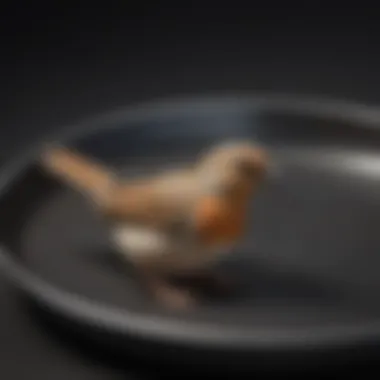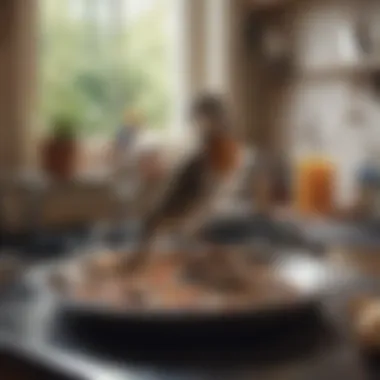Examining the Dangers of Teflon Pans for Bird Owners


Intro
Teflon pans are common in many kitchens, prized for their non-stick properties. However, their presence raises significant concerns, particularly for households with pet birds. Understanding the hazards of Teflon pans can help bird owners take proactive measures to safeguard their avian companions.
The key issue stems from the overheating of Teflon cookware. At high temperatures, the chemicals in Teflon can release toxic fumes. These fumes may be fatal for birds, whose respiratory systems are highly sensitive. This article aims to inform pet bird owners about these risks, provide safe cooking alternatives, and offer insights into creating a secure living environment.
Bird owners must grasp the serious implications of using Teflon in the kitchen. By ensuring safe cooking conditions, owners can reduce the risk of harm to their birds. The following sections will delve into practical care tips and alternative cookware options, helping to create a nurturing space for feathered friends.
Care Tips
Daily Care Routines
Monitoring common practices is essential for bird safety. If you plan to cook, ensure your kitchen is well-ventilated. Regardless of your cooking devices, keeping windows open or using exhaust fans can lessen potential airborne toxins. Include regular check-ins on your birds during cooking, allowing you to recognize any signs of distress quickly.
Cage Setup and Maintenance
Cages should be kept clean and strategically placed. Avoid putting the cage too close to the kitchen where hot air or smoke from cooking might migrate. Place perches, food, and water source within the cage to maximize bird security and comfort. Opt for materials like stainless steel for bowls and accessories to reduce any risk associated with toxic substances.
Hygiene and Cleaning Practices
Regular cleaning routines ensure a healthy environment for birds. Use natural cleaning products that do not contain harsh chemicals. This approach diminishes exposure to harmful substances. Wipe down cage surfaces frequently, and replace substrate materials to maintain hygiene. Healthy surroundings serve as a foundation to preventing many health problems.
Seasonal Care Adjustments
Seasons affect both cooking habits and bird care. In the warmer months, opt for grilling or outdoor cooking methods, lessening heat exposure indoors. Winters may push you back toward indoor cooking, emphasizing preventative measures like using alternative cookware that is bird-safe. Be mindful of fluctuations in household temperature, especially during cooking processes that may introduce additional heat.
Behavioral Insights
Understanding Bird Body Language
Observing bird behavior is crucial. Birds often display changes when they feel cold, stressed, or unsafe. Watching their posture, movement, and vocalizations can provide valuable feedback on their well-being.
Common Behavioral Issues and Solutions
Some birds may pluck their feathers or show signs of aggression due to various stressors. An environment free of toxins can reduce these issues. Consider engaging them in interactive play or offering rich stimuli to keep their minds active and curious.
Positive Reinforcement Techniques
Using positive reward systems when they play or explore helps produce encouraged behaviors. This method involves rewarding with treats or praise when they explore safely, strengthening a bond between owner and bird.
Social Interaction Needs
Birds are social creatures requiring attention and interaction beyond daily routines. Schedule quality time to help mitigate loneliness and potential behavioral problems.
Nutrition Guides
Essential Diet Components
Providing a well-rounded diet is vital. Include a variety of seeds, grains, fresh fruits, and vegetables. Each bird species comes with unique dietary needs. Understanding these requirements ensures optimal happiness and health.
Safe and Toxic Foods
Being mindful of food types is critical. Garlic, onion, chocolate, and avocado can be harmful or fatal for birds. Research pet-safe foods before introducing anything new to their diet.
Supplements and Treats
Supplements may promote better health, especially during molting or breeding seasons. Choose options tailored to specific species, offering shiny feathers and enhancements. Just ensure treats remain minimal to avoid unbalanced diets.
Feeding Strategies for Different Species
Tailoring feeding strategies based on species types can help provide what each bird requires. For example, larger birds might require larger seeds. Study and adjust feding approaches to deliver optimal nutrition.


Wellness and Health
Routine Health Checkups
Consistent veterinary visits contribute to prolonging your bird's life. Regular exams are necessary for identifying health concerns before they grow.
Identifying Symptoms of Illness
Recognizing symptoms proactively reduces the potential risks for your birds. Watch for changes in appetite, droppings, activity levels, or anything unusual. Early detection can potentially save a life.
Preventative Care and Vaccinations
Discuss specific vaccinations with a veterinarian. Preventative care measures can safeguard birds from numerous common threats, snowballing into heavier problems.
Mental and Emotional Well-being
Just like physical health, mental state counts significantly. Provide mental engagement through appropriate activities, ensuring a happy and flourishing bird.
Enriching Activities
Toys and Playtime Ideas
Include a variety of toys in the cage. Birds enjoy stimulating toys suitable for chewing and climbing. Change toys regularly to decrease boredom and discomfort.
Training and Tricks
Engaging in basic training sessions enriches their cognitive skills. Simple tricks may include flying to designated spots or mimicking words or phrases. Such interaction facilitates learning and bond-building.
Outdoor Activities and Interaction
Allowing contained outdoor time can broaden birds’ experiences. Introduce safe perches or riding spaces while providing proper supervision.
DIY Projects for Mental Stimulation
Create toys and enrichment setups using safe household materials. Supervising playtime with new items holds preventative safety benefits while reducing potential hazards.
Being informed is vital for bird owners. Ensuring the right environment and practices helps safeguard your feathered companion against threats, not only from Teflon pans but also overall care and wellness.
Understanding Teflon and its Composition
The comprehension of Teflon and its composition is vital in addressing the risks associated with Teflon pans, particularly for environments where pet birds are present. Teflon is widely recognized for its non-stick properties, which are of great convenience in cooking. However, this convenience often overshadows significant implications for both human health and animal welfare.
Teflon, or polytetrafluoroethylene (PTFE), serves a key role in numerous households, providing an easy clean-up routine due to its ability to prevent food from adhering to surfaces. Yet, this attribute may come with hidden dangers. Several concerns have emerged regarding its material stability when subjected to high cooking temperatures that go beyond common recommendations.
What is Teflon?
Teflon is a synthetic polymer with the chemical name polytetrafluoroethylene. Developed in the 1940s, its distinctive property of being hydrophobic makes it resistant to heat and practically non-stick. Typical cookware coated with Teflon allows food to cook evenly while minimizing stickiness that could contribute to overcooked or burnt meals.
Despite these redeeming features, a clear understanding of its physical state and safety is crucial. When Teflon is intact and used properly at appropriate temperatures, it remains safely usable for various food items. The threats only arise during extreme heat, which can lead to the decomposition of this coating and result in the generation of hazardous fumes.
The Chemistry Behind Teflon
The chemistry of Teflon presents several important factors to consider. Teflon comprises carbon and fluorine atoms arranged in a chain structure which contributes to its chemical resistance. The superb non-stick surface is due to this stable bond of carbon-fluorine which is one of the strongest in organic chemistry.
However, distinct conditions can exacerbate this stability. When heated above approximately 500°F (260°C), the chemical fidelity drops significantly. At such elevated temperatures, Teflon begins to degrade and can release harmful fumes that pose a severe risk, particularly to birds. Avian lungs are uniquely sensitive to toxins, meaning that exposures to Teflon degradation products could lead to rapid deterioration in health.
In summary, understanding Teflon's composition involves scrutinizing its benefits against potential risks. This juxtaposition will be increasingly important as we delve deeper into both human and avian health implications in subsequent sections, further informing pet bird owners about safe practices in the kitchen.
The Dangers of Teflon Pans
Understanding the dangers posed by Teflon cookware is essential for those who live with pet birds. This article investigates various risks associated with Teflon pans and structures vital guidance on healthier alternatives for avian companions.
The implications of Teflon's use in household kitchens can extend beyond human health, particularly in environments shared with birds. Recognizing these threats helps caregivers adequately protect their pets. Exploring some groundris for safer cooking practices becomes ever more important in light of these dangers.


Health Risks to Humans
While Teflon products are often marketed for their convenience and non-stick properties, they harbor potential threats to human health as well. The actual ingredient of concern in Teflon that has garnered attention is polytetrafluoroethylene (PTFE), a synthetic polymer. When exposed to high temperatures, Teflon can release toxic fumes. Among these are perfluorinated compounds, which are linked to serious health issues, including cancer and reproductive problems.
Health complications following prolonged exposure may be gradual, which can lead to disregard for the extent of risk. Insights vary greatly; thus bird owners must approach cookware decisions with awareness of cookware materials and associated dangers.
Teflon's Toxicity When Heated
One of the significant drawbacks of Teflon is how it reacts when heated beyond recommended limits. Optimal guidelines suggest cooking on medium or low heat, but many home cooks inadvertently exceed these recommendations.
At elevated temperatures, typically over 500 degrees Fahrenheit, Teflon begins to degrade, releasing harmful fumes into the air. Evidence shows these vapors can likely trigger respiratory complications in people and significantly distress birds. The potentially disastrous consequences are most present in well-ventilated areas. In addition, even seasoned cooks may not perfectly gauge when pans have surpassed safe temperatures.
Impact of Teflon on Avian Health
Teflon holds glaring potential hazards to avian companions. This fact significantly elevates itself in importance when discussing the environment of pet birds. Understanding the impact of Teflon is crucial for any bird enthusiast who desires a safe haven for their feathered friends. Not merely a cooking tool, it is the intersection of daily habits and pet safety that calls for thorough examination.
Teflon Fumes and Respiratory Issues
When Teflon pans reach high temperatures, they release toxic fumes. These gases primarily consist of polytetrafluoroethylene (PTFE) particles. Birds, compared to humans, are significantly more susceptible to these substances. Their small size and unique respiratory systems mean that even a small concentration of these fumes can pose dire consequences.
The respiratory distress caused by Teflon fumes may manifest in many ways such as difficulty breathing, coughing, or sudden lethargy. In severe cases, exposure can lead to death within hours. Factors influencing the severity of these reactions include duration and the amount of vapor inhaled. Always remember that birds have a heightened sensitivity to environmental factors, hence any poisoning signs should respond swiftly.
Important Notice: Ensure proper ventilation in kitchens if using Teflon products to mitigate the risk of harmful fumes.
Sensitivity of Pet Birds to Chemicals
Pet birds have a delicate biology. This fragility extends to their ability to process and handle chemicals. Many household products contain harmful elements that are naturally tolerated by humans including certain types of cookware. Teflon’s toxicity illustrates the considerable difference in tolerative thresholds.
Birds are particularly inquisitive creatures. They often explore their surroundings with beaks and lungs alike. This leads them to come into contact with synthetic smells and materials such as those utilized in Teflon pans. Studies indicate that even low-level exposure to Teflon compounds can elicit health issues ranging from ordinary to severe.
Consequently, it serves as paramount for pet owners to identify safer alternatives in cookware and to familiarize themselves with potential dangers when cooking. In many regions, responsible avian care entails staying vigilant about chemical exposures in their immediate habitats.
Educating yourself about Teflon and the associated risks becomes not just an option but a necessity to ensure pet bird welfare.
Regulatory Perspectives on Teflon
Understanding the regulatory landscape surrounding Teflon is essential for bird owners. Teflon is widely used in cookware and has specific rules governing its safety. Highlighting these regulations enables informed decisions, particularly when considering health impacts on sensitive pets like birds.
It's crucial to grasp the relevant guidelines and rules in place to manage the use of Teflon. Pet owners should prioritize regulatory insights to help them stay updated on product safety. Therefore, the analysis below will help to clarify key aspects.
Overview of Food Safety Regulations
Food safety regulations aim to ensure that materials used in cookware, including Teflon, are safe for both human consumption and environmental exposure. The United States Food and Drug Administration (FDA) and European Food Safety Authority (EFSA) are two main bodies responsible for food safety oversight. They monitor how substances, including perfluorinated compounds (PFCs) in Teflon, get disposed of and utilized in cookware production.
Proper handling and manufacturing of these materials is also crucial. Manufacturers must comply with strict guidelines, but concerns fluctuate based on product usage, raised temperatures, and exposure risks. Teflon when preserved within limits seems safe; however, when overheated, it can release chemicals harming both humans and birds. Keeping informed about current safety standards can protect avian friends effectively.
Historical Context of Teflon Regulation
Teflon, introduced commercially in the 1940s, underwent various regulatory phases as health research evolved. In its initial years, limited safety assessments meant that usage focused on cooking efficiency instead of long-term effects. Critical studies emerged in the late 20th century outlining potential dangers linked to overheated Teflon fumes.
Changes started rolling out in regulation after consumer organization and advocacy saw rise. By focusing on chemical transparency, several regulatory bodies initiated inquiries. This scrutiny helped reveal the gap between regulatory compliance and consumer safety.
As of now, stricter regulations have emerged to oversee manufacturers using PFCs in products, supported by safety studies regarding potential toxins released in specific conditions. Despite improvements, vigilance still matters as Teflon pans continue to be popular. Thus, understanding this history contextualizes current regulations, promoting greater awareness among bird owners about avian health and kitchen safety.
The safety of Teflon-based utensils remains a topic under ongoing scrutiny; caution is advised for households with birds.
Through comprehending the connections between regulatory frameworks and Teflon, bird owners can take steps to maintain a secure kitchen environment, ensuring safety from risks associated with cookware made of Teflon.
Alternatives to Teflon Cookware
Examining alternatives to Teflon cookware is essential for bird owners, especially in light of the potential risks associated with Teflon fumes. These alternatives provide safer cooking options that can mitigate health risks for both humans and their avian companions. It is important to consider not only safety but also functionality, ease of use, and long-term durability when selecting cookware that matches a bird-friendly kitchen.


Stainless Steel as a Safe Option
Stainless steel is a widely recognized alternative to Teflon cookware. It does not release harmful chemicals when heated, making it a safe choice for cooking. One highlight of stainless steel is its non-reactive nature, meaning it does not interact with foods. This quality preserves the integrity of your dishes anyway. Plus, stainless steel cookware can withstand high temperatures without degrading.
Considerations for Stainless Steel:
- Versatility: Works well for a variety of cooking methods
- Durability: Resistant to scratches and dents
- Maintenance: Usually dishwasher safe, making clean up easy
However, stainless steel does not offer a non-stick surface, which may necessitate the usage of more oil or cooking sprays. Proper heating and cooking techniques can create an effective non-stick environment, reducing the necessity for non-stick coatings.
Ceramic Cookware: Pros and Cons
Ceramic cookware provides another alternative to conventional Teflon pans. Unlike Teflon, ceramic does not contain PTFE or PFOA. It is designed with a non-stick surface, which can often feel similar to Teflon but lacks the associated risks. This cookware provides an appealing cooking surface due to its aesthetic appearance. However, certain factors must be considered.
Benefits of Ceramic Cookware:
- Non-toxic materials: Free from harmful chemicals
- Easy to clean: Most ceramic surfaces are dishwasher safe
- Aesthetic appeal: Available in various colors and designs
Drawbacks:
- Durability: Ceramic can be more prone to chipping or cracking than metal options
- Heat induction: Can have limitations depending on the type of ceramic and may not be suitable for high-heat applications over time
Cast Iron: A Traditional Choice
Cast iron cookware has stood the test of time, being both functional and reliable. Its resilience against high heat makes it a high-performing choice for many cooking styles. Cast iron does require some maintenance, as proper seasoning is necessary to maintain its non-stick properties and prevent rusting. However, when cared for, cast iron can last a lifetime.
Highlights of Cast Iron:
- Versatile: Suitable for stovetop, oven, and campfire cooking
- Even Heat Distribution: Ideal for slow-cooking and frying
- Healthy option: Can fortify food with iron, beneficial for many diets
"Choosing the right cookware is not just about functionality, but also about creating a safe environment for your pets."
Best Practices for Pet Bird Owners
Understanding the environment in which pet birds live is crucial for their health and well-being. Teflon pans, if overheated, can release toxic fumes that adversely affect avian life. With this in mind, pet bird owners must adopt proactive measures in their kitchens to create a safe atmosphere for their feathered companions. This includes careful monitoring of what is cooked, cooking temperatures, and ensuring that the space is suitable for birds.
Monitoring Cooking Temperatures
Cooking temperatures play a significant role in the safety of a household with birds. Teflon pans can release harmful fumes when heated beyond 500 degrees Fahrenheit. For bird owners, it is crucial to be vigilant while cooking. This means:
- Use a thermometer: An infrared thermometer can help monitoring surface temperatures quickly and effectively.
- Avoid high heat cooking: Favor low to medium heat settings. Foods that require frying or high-heat roasting pose a risk.
- Stay present in the kitchen: Always supervise the cooking process. If heat from a pan becomes too high, it’s prudent to turn the flame off and ensure ventilation is adequate.
By controlling heat levels, bird owners can prevent the release of hazardous gases that could endanger their pet's health. Creating a habit of checking the temperature will help in maintaining a safer cooking routine.
Creating a Bird-Safe Kitchen Environment
Establishing a kitchen environment that prioritizes avian comfort and safety is vital. Various elements come into play that can support bird-friendly cooking. Below are some practices to consider:
- Ventilation: Always use exhaust fans whenever possible to help dissipate any fumes. Crack open windows during cooking to allow fresh air to circulate.
- Keep birds out of the kitchen: Designate a safe area away from the cooking zone for birds. This minimizes the risk of exposure to any fumes or dangers that may arise.
- Choose cooking tools wisely: Opt for cookware made from safer materials. Stainless steel and glass are alternatives with fewer controversial heat-related issues.
It's recommended that bird owners prioritize their pets' safety in kitchen practices.
Taking these steps contributes significantly towards reducing risks associated with cooking, allowing bird owners to enjoy meal preparation while safeguarding their pets' health. With careful consideration, a safe living space for birds and humans can be achieved.
The End
This discussion elucidates the multifaceted concerns surrounding Teflon pans, particularly for households containing pet birds. Understanding these dangers is essential. The article connects the health risks posed to birds from Teflon fumes with practical strategies for ensuring a safer cooking environment.
Summarizing the Key Points
To recap, key points have included:
- Teflon Composition and Heating Risks: Teflon, when exposed to high temperatures, releases hazardous fumes that jeopardize avian health. This chemical volatility can lead to severe respiratory issues in birds, a fact that mandates vigilance in kitchens where both cookware and feathered companions coexist.
- Alternative Cookware: The necessity of exploring alternatives like stainless steel or ceramic materials manifestly emerges. These options frequently present safer cooking conditions, averting the toxic risks posed by traditional Teflon. For bird owners, transitioning to safer cookware becomes not merely an option, but a priority.
- Creating a Safe Environment: Strategies such as maintaining appropriate cooking temperatures and ensuring effective ventilation can dramatically diminish the exposure risks for birds. Dogmatic adherence to these practices is invaluable to minimizing health threats and enhancing life quality for avian friends.
In summary, comprehending the innate dangers linked to Teflon enables better decision-making to safeguard pet birds from chemical toxins.
Final Thoughts for Bird Owners
For owners of pet birds, it is crucial to acknowledge the potential hazards associated with Teflon cookware. Educating oneself is the foundation of making optimal choices that prioritize both personal health and that of their avian companions. Diligently monitoring cookware, choosing safer alternatives, and ensuring a bird-friendly environment are imperative takeaways drawn from this examination.















